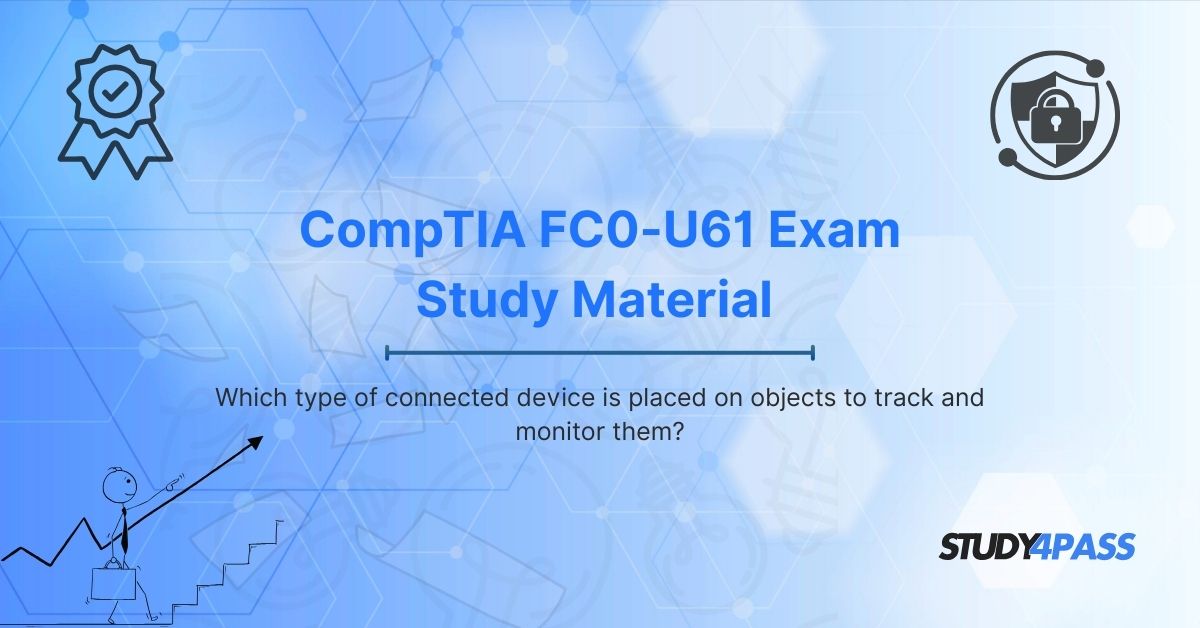Introduction to Connected Devices and Tracking Technologies
In today's digitally connected world, businesses and individuals rely on smart devices to track and monitor objects efficiently. These connected devices leverage technologies like Radio-Frequency Identification (RFID), Global Positioning System (GPS), Bluetooth, Near Field Communication (NFC), and Internet of Things (IoT) sensors to provide real-time data on object location, condition, and movement.
For IT professionals and students preparing for the CompTIA IT Fundamentals (FC0-U61) exam, understanding these technologies is crucial. This article explores different types of tracking devices, their functionalities, and their relevance in IT fundamentals.
What Are Tracking and Monitoring Devices?
Tracking and monitoring devices are small electronic tools attached to objects to collect and transmit data about their location, temperature, movement, or other environmental factors. These devices are widely used in logistics, healthcare, retail, and manufacturing.
Key features:
- Real-time tracking
- Wireless connectivity
- Data logging and analytics
- Automated alerts
Types of Connected Devices Used for Tracking and Monitoring
A. RFID Tags (Radio-Frequency Identification)
RFID tags use electromagnetic fields to automatically identify and track objects. They consist of:
- Passive RFID: No battery, powered by reader signals (short-range).
- Active RFID: Battery-powered, longer range.
Applications:
- Inventory management
- Supply chain tracking
- Access control systems
B. GPS Trackers
GPS (Global Positioning System) devices use satellite signals to determine precise locations.
Types:
- Personal GPS trackers (e.g., for vehicles, pets)
- Asset tracking GPS (e.g., shipping containers)
Applications:
- Fleet management
- Theft prevention
- Outdoor activity tracking
C. Bluetooth Beacons
Bluetooth Low Energy (BLE) beacons transmit signals to nearby devices like smartphones.
Applications:
- Indoor navigation (malls, airports)
- Proximity marketing
- Smart retail experiences
D. NFC Tags (Near Field Communication)
NFC allows short-range wireless communication (within a few centimeters).
Applications:
- Contactless payments
- Smart posters
- Access control
E. IoT Sensors
IoT (Internet of Things) sensors collect data and transmit it over the internet.
Examples:
- Temperature sensors
- Motion detectors
- Humidity sensors
Applications:
- Smart homes
- Industrial automation
- Healthcare monitoring
F. Barcode and QR Code Scanners
These optical scanners read encoded data for tracking.
Applications:
- Retail checkout
- Warehouse management
- Event ticketing
How These Devices Work?
- RFID: Uses radio waves to exchange data between a tag and reader.
- GPS: Communicates with satellites to determine location.
- Bluetooth Beacons: Broadcast signals to nearby devices.
- NFC: Requires close proximity for data exchange.
- IoT Sensors: Collect and transmit data via Wi-Fi/cellular networks.
Applications in Various Industries
- Logistics: GPS and RFID for shipment tracking.
- Healthcare: IoT sensors for patient monitoring.
- Retail: Bluetooth beacons for customer engagement.
- Manufacturing: RFID for inventory control.
Security and Privacy Concerns
- Data breaches (unauthorized tracking)
- Signal interception (RFID cloning, GPS spoofing)
- Privacy laws compliance (GDPR, CCPA)
Benefits of Using Tracking and Monitoring Devices
- Improved efficiency
- Reduced losses (theft prevention)
- Automated workflows
- Enhanced customer experience
CompTIA IT Fundamentals (FC0-U61) Exam Focus
The FC0-U61 exam covers:
- IoT concepts
- Networking fundamentals
- Device connectivity
- Data tracking technologies
Understanding these tracking devices aligns with IT Fundamentals (ITF+) certification objectives.
Why Choose Study4Pass for CompTIA IT Fundamentals Preparation?
Study4Pass is a leading platform for CompTIA certification training, offering:
- Comprehensive FC0-U61 study guides
- Practice exams with real-world scenarios
- Interactive learning modules
- Expert-led video tutorials
Boost your IT career with Study4Pass structured and exam-focused resources!
Conclusion
Tracking and monitoring devices like RFID, GPS, Bluetooth beacons, NFC, and IoT sensors play a vital role in modern IT infrastructures. For CompTIA IT Fundamentals (FC0-U61) aspirants, mastering these concepts is essential.
Leverage platforms like Study4Pass for effective exam preparation and gain a competitive edge in IT certifications.
Special Discount: Offer Valid For Limited Time “FC0-U61 Exam Prep Practice Tests PDF Free Download”
Actual Exam Questions For CompTIA's FC0-U61 Study Guide
Sample Questions For CompTIA FC0-U61 Mock Test
1. Which type of connected device is used to track and monitor objects?
a) Smartphone
b) IoT sensor
c) Laptop
d) Router
2. What is the primary purpose of attaching a tracking device to an object?
a) To increase its weight
b) To monitor and track its location or status
c) To improve its internet speed
d) To change its color
3. Which technology is commonly used in devices that track objects?
a) RFID or GPS
b) Bluetooth speakers
c) LED displays
d) Solar panels
4. In logistics, which device helps in real-time tracking of shipments?
a) Barcode scanner
b) GPS tracker
c) Smartwatch
d) Printer
5. Which of the following is an example of an object-tracking device?
a) Smart bulb
b) Tile tracker
c) Digital camera
d) Microwave oven


